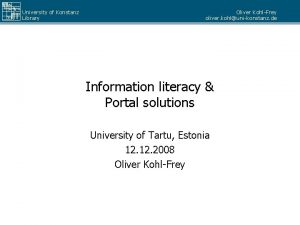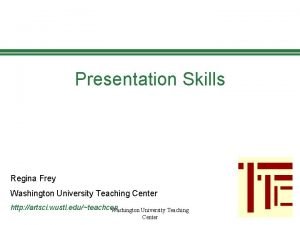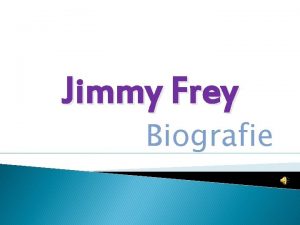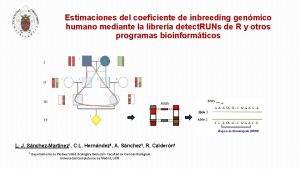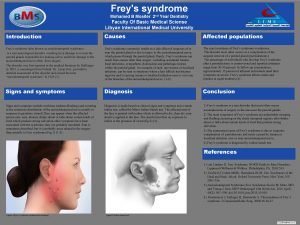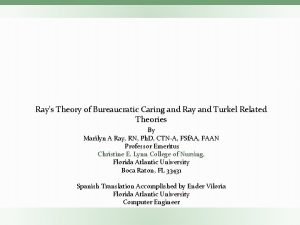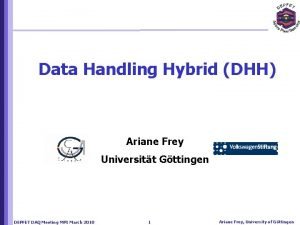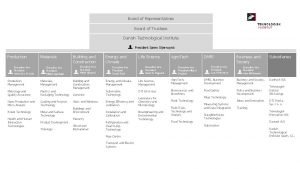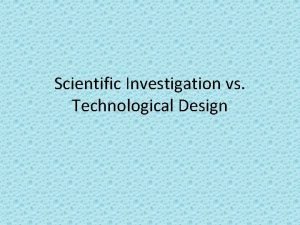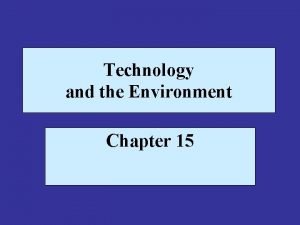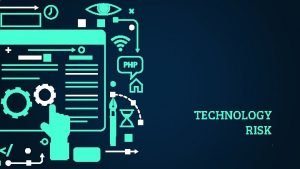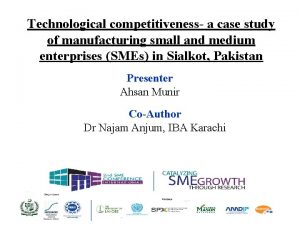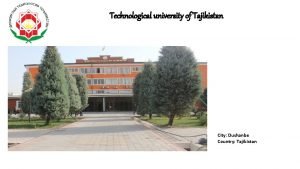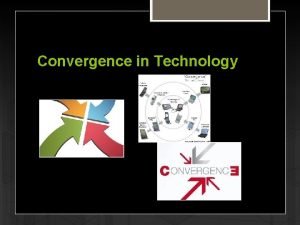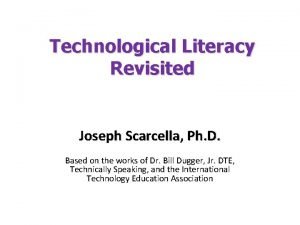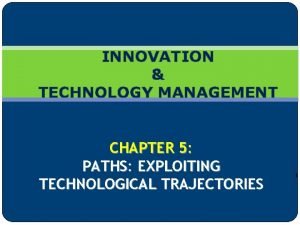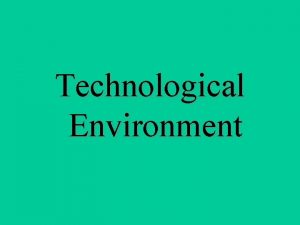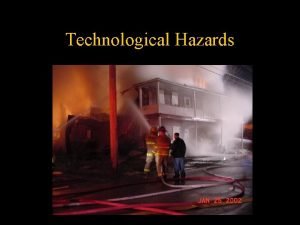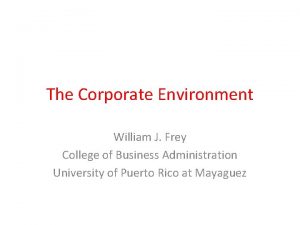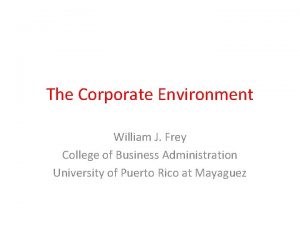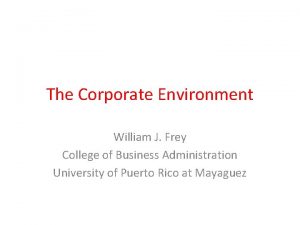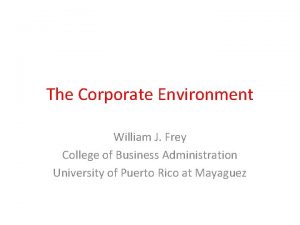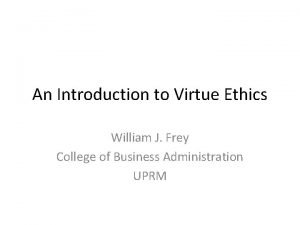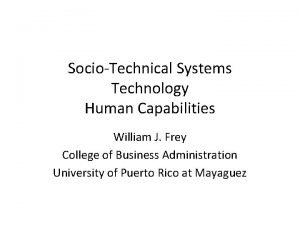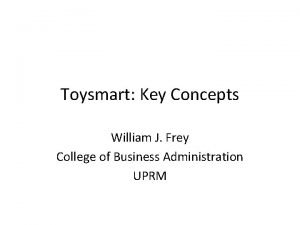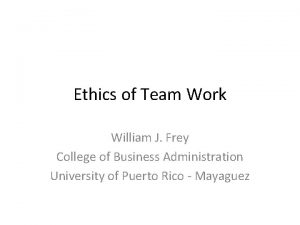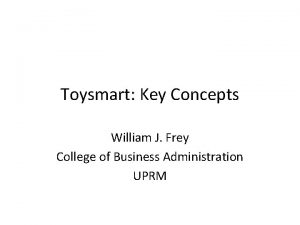The Technological Environment William J Frey Professor of




































- Slides: 36

The Technological Environment William J. Frey Professor of Business Ethics College of Business Administration University of Puerto Rico at Mayaguez

Vocabulary • Artifacts: objects that are not found in nature but are made, designed, and created by humans • Social Artifacts: “play a role in ruling the behavior of humans, their natural cooperation and the relationships between humans and social institutions” Vermaas 11 – laws, government, state, marriage, driving license, traffic laws, currency (money), organizations (corporations), contracts (including social contracts) • Artistic artifacts: works of art created for enjoyment and beauty • Technical artifacts: “material objects that have been deliberately produced by humans in order to fulfill some kind of practical function. ” Vermaas, 5 – technical function – physical composition – instructions for use (use or user guide) • Technology: the knowledge and skill that goes into the making of technical artifacts – Applied science – Craft and skill (handed down from generation to generation) – Engineering?

Zooming In on Frey’s Toys • Portable Typewriter • Radio • Taino Clock • Gecko • Brick • Pirates Creed of Ethics • Zoom in – Physical Structure – Classify – Function (User Manual)

Hypothesis 1 • Society determines technology – SCOT argues that technologies pass through three stages: interpretive flexibility, closing of interpretive flexibility, and the emergence of the technical “black box. ” – From Penny Farthing bicycle to modern design (based on Lawson bicycle) – Typewriter and the QWERTY keyboard • Pinch and Bijker (Social Construction of Technology)

Hypothesis 2 • Technology determines society (Nuclear Plants) • Winner and Perrow – Complexity (manifest and latent) • tightly coupled systems—difficult to control because it is impossible to isolate failures • non-linear causality—effects of acts ripple throughout system; non-linearity makes it difficult to predict the consequences of actions – Reverse Adaptation • Because complex technologies redefine needs (and values), we are forced to adapt ourselves (and our needs) to them. – Technological Imperative • Technologies transform and redefine human needs. Machine needs become imperative and trump human needs.

Hypothesis 3 • Technology and society influence one another. • A technical artifact is enrolled into a sociotechnical system – The artifact is modified to fit the existing STS • But often, technical artifacts stimulate changes in the surrounding STS – Computers, cars, cell phones

Neutrality Thesis • “from a moral point of view a technical artifact is a neutral instrument that can only be put to good or bad use…used for morally good or bad ends, when it falls into the hands of human beings. ” (Vermaas 16) – Guns don’t kill people; people kill people. – At stake—Who is responsible for harms produced by the use or abuse of technology: the user or the designer?

Value-Laden Thesis • Values can be designed into technical artifacts – Howe, Flanagan, Nissenbaum – Value Discovery, Value Translation (operationalization and implementation) and Value Verification • Value Sensitive Design • Oosterlaken: Zooming in and Zooming out – “Zooming in…allows us to see the specific features or design details of technical artifacts; zooming out…allows us to see how exactly technical artifacts are embedded in broader sociotechnical networks and practices. ” • • Flanagan, Howe, and Nissenbaum, “Embodying Values in Technology” in Information Technology and Moral Philosophy, van den Hoven and Weckert. (See Taking a Capability Approach to Technology and Its Design: A Philosophical Exploration, Introduction, 14. Simon Stevin Series in the Ethics of Technology). (See Taking a Critical Approach to Technology and Its Design 13 (table) and 14. )

The ontology of a technical artifact • Technical artifacts are relational; they must be understood in relation to different contexts • Context-dependency in Waste for Life Case – Hot press works in Lesotho but doesn’t work in Buenos Aires • Social context (One of many “environments”) – Technical artifact must be understood in terms of how it functions in social surroundings – Social factors can frustrate functioning of artifact – Users can be subversive and circumvent designer’s intention (Gecko flute can be a pencil/pen holder)

Socio-Technical System Interrelated Environments that Constrain and Enable

1. Socio-Technical System • Socio-Technical System “an intellectual tool to help us recognize patterns in the way technology is used and produced” (Huff, “What is a Socio-Technical System? ” from Computing Cases) • Socio-Technical systems provide a tool to uncover the different environments in which business activity takes place and to articulate how these constrain and enable different business practices.

2. Socio-Technical System • A STS can be divided into different components such as hardware, software, physical surroundings, stakeholders, procedures, laws, and information systems. – These environments constrain and enable activities individually and collectively – Think about how the physical environment of the classroom embodies distinct pedagogical styles

3. Socio-Technical System • While different components can be distinguished these are inseparable. STSs are systems composed of interrelated and interacting parts. – “A system is a complex environment of interacting components, together with the networks of relationships among them, that identifies an entity or a set of processes. ” (Werhane, Alleviating Global Poverty [21] referring to Laszlo & Krippner) – “Systems thinking is the habit of mind that considers any social entity as a complex interaction of individual and institutional actors each with conflicting interests and goals

4. Socio-Technical System • STSs also embody values – moral values (justice, responsibility, respect, trust, and integrity) – non-moral values (efficiency, satisfaction, productivity, effectiveness, and profitability). – Often these values can be located in one or more of the system components. • These values conflict with one another causing the system to change. – Value vulnerabilities. Latent and Potential Harms

Value Realization (Again) • Values are designed into a STS through… – Discovery – Translation • Operationalization • Implementation – Verification • • • internal testing, user testing in controlled environments, formal and informal interviews and surveys, prototypes, traditional quality assurance measures Flanagan, Howe, and Nissenbaum, “Embodying Values in Technology” in Information Technology and Moral Philosophy, van den Hoven and Weckert.

5. Socio-Technical System • STSs change and this change traces out a path or trajectory. – The normative challenge of STS analysis is to find the trajectory of STS change and work to make it as value positive and valuerealizing as possible.

Example of a Socio-Technical System Table (ADMI 4016 in 236) Technology Software Physical Stake. Surround- holders ngs Procedures Laws (univ Information regs) systems Classroom Computers Microsoft Office (Social Networking Media) Describe classroom and show constrains interaction Give one of your procedures for value realization Rules on research misconduct Smart Board Data Display Projector Internet Connection Google Documents Gantt Charts (Holding discussions with more than three) Teacher, your group members, you, other teachers, other classmates Matricula (Does this Your boss procedure (if you have embody or a job frustrate outside of justice? ) the univ) Crazy Calendar (changing MWF to TTh; No exams in last week) How your group assembles dispersed information Transferring information across STSs Informed Consent (providing info to others)

STS Summary • Socio-Technical systems provide a tool to uncover the different environments in which business activity takes place and to articulate how these constrain and enable different business practices • A STS can be divided into different components such as hardware, software, physical surroundings, stakeholders, procedures, laws, and information systems • But while different components can be distinguished these are, in the final analysis, inseparable. STSs are, first and foremost, systems composed of interrelated and interacting parts. • STSs also embody values such as moral values (justice, responsibility, respect, trust, and integrity) and non-moral values (efficiency, satisfaction, productivity, effectiveness, and profitability). Often these values can be located in one or more of the system components. • STSs change and this change traces out a path or trajectory. The normative challenge of STS analysis is to find the trajectory of STS change and work to make it as value positive and value realizing as possible.

Responsible Technological Choice AT Case Frameworks One Laptop Per Child 1. Serves Humans 2. Labor Intensive 3. Simple, not Complex 4. De-centralized 5. Gentle in Use of Resources 1. Zoom In 2. Zoom Out 3. Appropriateness 4. Capabilities Technology addresses “conversion factors” and thus instruments changing capabilities into functionings Removing gender bias from airplane cockpit design Uchangi Dam (eng as honest broker) Amish (exercise of technological choice) Aprovecho Case (NGO designs and tests wood-burning cooking stoves) Waste for Life (Press that makes building materials out of waste products)

Responsive Technological Choice: One Laptop Per Child http: //en. wikipedia. org/wiki/OLPC_XO-1 / K. Kraemer, J. Dedrick, and. P. Sharma “One Laptop Per Child: vision vs. Reality” Communications of the ACM 52(6): 66 -73 http: //en. wikipedia. org/wiki/OLPC_XO-1

Responsive Technological Choice: Case 2 Redesigning airplane cockpits to remove gender bias http: //www. aviationexplorer. com/a 350_facts. htm Manufacturing Gender in Commercial and Military Cockpit Design Rachel N. Weber Science, Technology, & Human Values, Vol. 22, No. 2. (Spring, 1997), pp. 235 -253. http: //www. jstor. org Tue Jan 2 16: 14: 06 2007

Responsive Technological Choice: Case 3 Bridging the gap between government and local communities in the Uchangi Dam Project How engineers and other professionals with NGOs can serve as mediators or honest brokers in disputes on technological choice Professionals work with local communities to “give them voice. ” Roopali Phadke. “People’s Science in Action: The Politics of Protest and Knowledge Brokering in India. ” In Tecnology and Society, Johnson and Wetmore eds. MIT Press, 2009, 499 -513.

Responsive Technological Choice: Case 4 How the Amish adopt and adapt technology Using technological choice to build a community’s identity Assessing how a technology would impact a community’s core values Modifying existing technology to minimize negative impact on a community’s values http: //amishbeat. wordpress. com/ Jamison Wetmore. “Amish Technology: reinforcing Values and Building Community” in Technology and Society, eds. Johnson and Wetmore. 2009, MIT Press: 298 -318

Choosing Your Topic • Tie to your areas of interest and research • Look for issues such as… – Community Development Project – Technical Devices (in the widest sense) being deployed – Underlying Social, Physical, and Historical Context • Topic should be supported with reliable, accessible information • Look for information on its socio-technical system • Topic should be interesting and engaging. The time you spend preparing it should be time well spent.

1. Provide an Executive Summary • Acquaint the poster viewer with highlights of your appropriate technology, the socio-technical system in which it functions, whether it is appropriate, and how it stands with human capabilities

2. Zoom in on your case’s main technical artifact • Classify the artifact – Social – Artistic – Technical • Describe its physical characteristics and how its parts fit together • Outline what the artifact is doing when it is functioning as it was designed to function – Are there any “work arounds” that is functionings that were discovered after the product left the designer’s laboratory? • Provide user instructions that help users deploy the technical artifact or release it for its proper functioning

3. Zoom out by describing the sociotechnical system • Identify the key sub-environments like… – Hardware, software, physical surroundings, people/groups/roles, procedures, laws, information systems • How do these constrain the functioning of the artifact? • How do these enable the functioning of the artifact? • Prepare a socio-technical system to summarize the results of your STS description • What is the trajectory of the STS? Is it value positive or negative?

Like this one… Technology Software Physical Stake. Surround- holders ngs Procedures Laws (univ Information regs) systems Classroom Computers Microsoft Office (Social Networking Media) Describe classroom and show constrains interaction Give one of your procedures for value realization Rules on research misconduct Smart Board Data Display Projector Internet Connection Google Documents Gantt Charts (Holding discussions with more than three) Teacher, your group members, you, other teachers, other classmates Matricula (Does this Your boss procedure (if you have embody or a job frustrate outside of justice? ) the univ) Crazy Calendar (changing MWF to TTh; No exams in last week) How your group assembles dispersed information Transferring information across STSs Informed Consent (providing info to others)

4. Discuss your technology and case using criteria of appropriate technology such as… • • • Ecologically sound Low-cost Low-maintenance Labor intensive Energy efficient Simple, efficient, nonviolent • Oosterlaken et al on Appropriate Technology • Conducive to decentralization • Compatible with laws of ecology • Makes use of modern knowledge • Gentle in the use of resources • Serves the human person • Production by the masses

5. Evaluate your technology using the Capability Approach • Does your technical artifact serve as a conversion factor that helps individuals turn capabilities into functionings? • What environmental/STS features stand in the way of the realization of the capabilities you have chosen? • Is your technical artifact a personal, social, or environmental conversion factor?

Types of Capabilities • Basic Capabilities Life Bodily health Bodily integrity • Cognitive Capabilities Senses / imagination / thought Emotions (“not having one’s emotional development blighted by fear and anxiety”) practical reason (liberty of conscience and religious observance)

Types of Capabilities • Social or Out-reaching Capabilities – Affiliations – “live with and toward others, to recognize and show concern for other human beings, to engage in various forms of social interaction; to be able to imagine the situation of another(freedom of assembly and speech) – “Having the social bases of self-respect and nonhumiliation; being able to be treated as a dignified being whose worth is equal to that of others (nondiscrimination) – Other Species – “Being able to live with concern for and in relation to animals, plants, and the world of nature. ”

Types of Capabilities • Agent Capabilities –Play –Control over one’s environment • “Political. –Being able to participate effectively in political choices that govern one’s life; having the right of political participation, protections of free speech and association. ” • Material. –Being able to hold property (both land movable goods), and having property rights on an equal basis with others; – having the right to seek employment on an equal basis with others; – having the freedom from unwarranted search and seizure. –In work being able to work as a human being, exercising practical reason and entering into meaningful relationships of mutual recognition with other workers

Conversion Factors • Means that realize capabilities into functionings Resources, tools, technologies • Personal Metabolism, physical condition, sex, reading skills, gender, race, caste • Social Public policies, social norms, practices that unfairly discriminate, societal hierarchies, power relations related to class or gender, race, caste. • Environmental Physical or built environment, climate, pollution, proneness to earthquakes, presence or absence of seas or oceans

6. Develop a poster (electronic) on your case for presenting to the class • Poster will… – Zoom in – Zoom out – Discuss Appropriateness (apply criteria) – Choose two Capabilities to evaluate technology • Provide a STS table to encapsulate your STS analysis • Summarize strategically and use images to get your point across • Give rise to a conversation, not a presentation.

THANK-YOU WILLIAM J. FREY, COLLEGE OF BUSINESS ADMINISTRATION, UNIVERSITY OF PUERTO RICO AT MAYAGUEZ Moral Imagination Realizing capabilities Understanding Moral Expertise Developing profitable partnerships to alleviate poverty
 Dr william frey
Dr william frey Dr william frey
Dr william frey Micro environment factors
Micro environment factors Promotion from associate professor to professor
Promotion from associate professor to professor Alan frey
Alan frey Canciones belgas más famosas
Canciones belgas más famosas Uni konstanz library
Uni konstanz library Klaus dieter frey
Klaus dieter frey Hans dieter frey
Hans dieter frey Regina frey
Regina frey Jimmy frey woonplaats
Jimmy frey woonplaats Frey gebäudereinigung
Frey gebäudereinigung Frey’s syndrome
Frey’s syndrome Frey gebäudereinigung
Frey gebäudereinigung Coeficiente de inbreeding
Coeficiente de inbreeding Frey syndrome symptoms
Frey syndrome symptoms Samina frey
Samina frey What is the theory of bureaucratic caring
What is the theory of bureaucratic caring 12 step foolproof sales letter template
12 step foolproof sales letter template Iris frey attac
Iris frey attac Ariane frey
Ariane frey Sibylle frey
Sibylle frey Porque mecanismo ocurre la pérdida de calor
Porque mecanismo ocurre la pérdida de calor Magalie frey
Magalie frey Financial environment of business
Financial environment of business Danish technological university
Danish technological university Ascoulor
Ascoulor Scientific vs technical
Scientific vs technical Technological dualism
Technological dualism Definition of technology risk
Definition of technology risk Technological gap and product cycle model
Technological gap and product cycle model Technological competitiveness
Technological competitiveness Technological university of tajikistan
Technological university of tajikistan Neil postman five things
Neil postman five things What is technological convergence
What is technological convergence Technological literacy definition
Technological literacy definition 5 major technological trajectories
5 major technological trajectories






